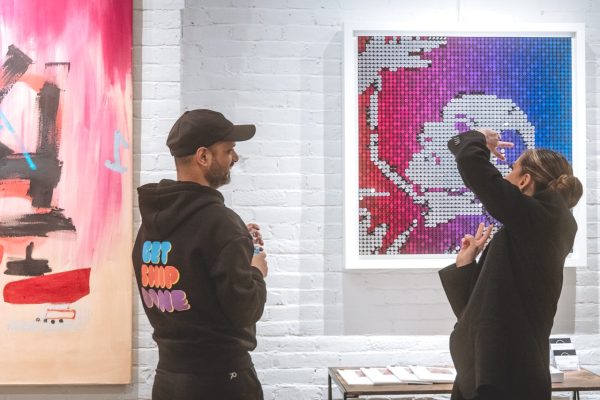NFTs are misunderstood. For most, they’re just money. For others, they’re overrated. But for one night at the Pellas Art Gallery on 73 Newbury Street last Friday April 4, NFTs were celebrated.
The Women in Blockchain NFT Art Show was the first-of-its-kind in Boston to feature all women artists. The event was organized by Amanda Cirello, logistics director at the Massachusetts Institute of Technology’s 12th annual Bitcoin Expo, which followed the show that weekend.
Harsh Vardhan, the Expo’s co-director, explains that digital art and digital currencies both suffer from a phenomenon called “double spend” because they are both files that can be copied and pasted like any other, things like art and money become meaningless.
“NFTs give digital art value. Artists were not getting paid before,” said Vardhan. “Now after the blockchain, we can take that computer file and create a digital fingerprint of it and store it on the blockchain, and that’s the only real copy of that artwork.”
The artwork’s digital information gets cryptographically verified and assigned to an owner on the blockchain. That’s what makes it a token. The “Non Fungible,” or the “NF” part of NFT, means the file is non-divisible and has no duplicates.
“Blockchain is basically public storage of information that can’t be changed. Ultimately, it’s a timestamp,” said Vardhan.

The exhibit also featured TIME Magazine artist-in-residence Nyla Hayes, currently working on a 15-minute pilot episode for her debut preschool series “Nyla’s Long Neckie World,” a project featuring voice-overs and animation, expected in the fall.
The short film, named after her 2021 art series, “Long Neckie Ladies,” a hand-drawn, computer-generated series of 3,333 women with long necks inspired by her favorite dinosaur, the Brontosaurus, sold on the Ethereum blockchain.
“All of [the artist’s] stories are so amazing. Nyla sold four million dollars worth of NFT art when she was 12. She’s only 16 now,” said Cirello.
“Heart Space” is the latest piece by Canadian-Korean contemporary artist Krista Kim. An immersive experience, viewers put their palm on a screen, and the artwork itself records and tracks each user’s heartbeat via electrocardiogram signal, graphing each unique signature with colorful wavelengths. And by the end of the night, a version of the piece was up for sale.
NFTs may be controversial, that’s the truth. Consider Emerson’s student body—and those of most liberal arts colleges even, who already vehemently reject the use of AI in creative industries.
Vardhan says NFTs are an immutable and legitimate way of preserving art in an age that insists on its destruction. The exhibit celebrated that much.
“We had art from Ukraine where women take their art and put it on the blockchain to preserve their culture because their physical art is being destroyed.”
In an age where cultures are erased overnight, art like this is precious in its permanence.
“There’s a space for digital art within physical art. And art is art, it just makes you feel things,” said Cirello. “I wanted to build something that showcases women in [the industry] because the tech world has a lot of men dominating that space.”